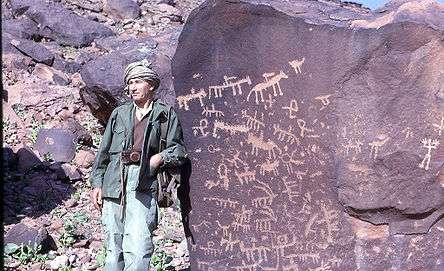Henri Lhote

Henri Lhote (1903–1991) was a French author, explorer, ethnographer, and "expert on prehistoric cave art"[1] who described and is credited for the discovery of "important cave paintings"[2] in an "assembly of 800 or more magnificent works of primitive art...in a virtually inaccessible region on the edge of the Sahara desert"[1] Lhote was an early ancient astronaut theorist and considered the prehistoric art as evidence of paleocontact.[3][4][5][6]
Tassili n'Ajjer
In 1933, a French soldier remembered as "Lieutenant Brenans" ventured into a deep wadi in the Tassili-n-ajjer plateau in the southeast Algeria. Although by the 20th century Tassili-n-ajjer was barren and devoid of large animals, there, upon the sandstone cliffs, he saw rock paintings and engravings of elephants, giraffes, rhinoceroses. He also saw images of strange human figures.[1][6]
Lhote, a pupil of "the great expert on prehistoric cave art in France"[1] Abbé Breuil, was in Algeria at the time and heard about the discovery. He met the soldier at Djanet, learned all he could, then and mounted an expedition to investigate it.[1] Lhote later wrote that he had never seen anything "so extraordinary, so original, so beautiful" as the art at Tassili n'Ajjer. Working with the support of the Musée de l'Homme, Lhote and his associates discovered about 800 paintings, many of which he later made images of with the aid of painters and photographers.[1][6]
These images were presented in 1957 and 1958 at the Musée des Arts Décoratifs in Paris and were, in the opinion of André Malraux. "one of the most defining exhibitions of the mid-century".[6]
Ancient Astronauts

After thoroughly exploring and uncovering many more images, Lhote publicized the hypothesis that the humanoid drawings represented space aliens. In The Search for the Tassili Frescoes: The story of the prehistoric rock-paintings of the Sahara (first published in France in 1958 and in London in 1959), Lhote called one particularly large and "curious figure"[2] as "Jabbaren" and described him as the "great Martian god."[2][5]
The popular press gave much attention to Lhote's hypothesis of a prehistoric close encounter and it was later incorporated into the '"sensationalist claims" made by Erich von Däniken that ancient extraterrestrial astronauts visited prehistoric Earth.[2]
According to the Encyclopædia Britannica a "vivid dance scene" that Lhote discovered in 1956 can be attributed on stylistic grounds to Neolithic hunters that lived in the Sahara circa 6000 to 4000 BCE.[4] Mainstream scientists regard the "great Martian god" and other rock art figures that are similar to it as representations of ordinary humans in ritual masks and costumes rather than the representations of extraterrestrial lifeforms.[2]
The value of Lhote's scholarship was also challenged by The Journal of North African Studies, an academic journal affiliated with the University of East Anglia:
Following a highly publicised expedition in the 1950s, the Tassili-n-Ajjer mountains of the Central Sahara (Algeria) were presented to the world as 'the greatest museum of prehistoric art in the whole world'. Many of the claims of the expedition's leader, Henri Lhote, were misleading, a number of the paintings were faked, and the copying process was fraught with errors. The 'discovery' can only be understood within the political and cultural context of the time, namely the Algerian Revolution, France's attempt to partition Algeria, and the prevailing views of the Abbé Breuil, the arch-advocate of foreign influence in African rock art. The expedition's methods caused extensive damage to the rock art while the accompanying looting of cultural objects effectively sterilized the archaeological landscape. Any restitution process must necessarily include a full recognition of what was done and the inappropriateness of the values.[7]
Namesakes
The "Ouan Lhote Area"[8] and the "Henri Lhote Arch"[9] in Tassili National Park are named after him.
A species of North African lizard, Philochortus lhotei, was named in his honor.[10]
Selected publications
- Aux prises avec le Sahara, (Les œuvres françaises, Paris, 1936).
- Le Sahara, désert mystérieux, (Editions Bourrelier, Paris, 1937; 1949).
- L'extraordinaire aventure des Peuls. Présence Africaine. Paris. Oct.-Nov. 1959. pp. 48–57
- Les Touaregs du Hoggar, (Payot, Paris, 1944; 1955; A. Colon, Paris, 1984).
- Le Niger en kayak, (Editions J. Susse, Paris, 1946).
- Dans les campements touaregs, (Les œuvres françaises, Paris, 1947).
- La chasse chez les Touaregs, (Amiot-Dumont, Paris, 1951).
- A la découverte des fresques du Tassili, (Arthaud, Paris, 1958, 1973, 1992, 2006).
- L'épopée du Ténéré, (Gallimard, Paris, 1961).
- Les gravures rupestres du Sud-oranais, (Arts et Métiers graphiques, Paris, 1970).
- Les gravures rupestres de l'Oued Djerat, (SNED, Algiers, 1976).
- Vers d'autres Tassilis, (Arthaud, Paris, 1976).
- Chameau et dromadaire en Afrique du Nord et au Sahara. Recherche sur leurs origines, (ONAPSA, Alger, 1987).
- Le Sahara, (Grandvaux, 2003).
See also
External links
| Wikimedia Commons has media related to |
In French:
- Rock art of the Sahara
- Henri Lhote, The amazing adventure of the Peuls (1959)
- Engravings and paintings of Tassili N'Ahaggar
References
- 1 2 3 4 5 6 "Paintings from the Past" in the January/February 1983 print edition of Saudi Aramco World
- 1 2 3 4 5 Internet Encyclopedia of Science
- ↑ Author: Henri Lhote (librarything.com)
- 1 2 Encyclopædia Britannica. Retrieved August 29, 2008
- 1 2 Lhote, Henri. The Search for the Tassili Frescoes: The story of the prehistoric rock-paintings of the Sahara. New York: E. P. Dutton.
- 1 2 3 4 Ita, J.M., 'Frobenius, Lhote and Saharan Studies', in African Studies Review Vol. 17 no. 1 (April 1974), pp. 286–306.
- ↑ "Lesser Gods of the Sahara", The Journal of North African Studies, University of East Anglia Saharan Studies Programme
- ↑ Natural Arches of Tassili National Park
- ↑ Henri Lhote Arch (archmillennium.net)
- ↑ Beolens B, Watkins M, Grayson M. 2011. The Eponym Dictionary of Reptiles. Baltimore: Johns Hopkins University Press. xiii + 296 pp. ISBN 978-1-4214-0135-5. ("Lhote", p. 157).